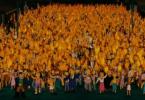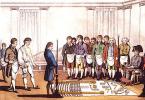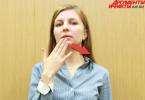The infusoria shoe is a fairly common species that belongs to the group. It lives in fresh stagnant water bodies with a sufficient amount of organic materials that it feeds on. By the way, the structure of ciliates-shoes is considered the most complex of this group of organisms.
general characteristics
Infusoria shoe is a unicellular organism, the shape of which really resembles the sole of a shoe and is preserved due to the dense outer layer of the cytoplasm. The entire body of the animal is covered with a huge number of cilia, which are arranged in longitudinal rows. Their main function is movement.
The ciliate shoe moves with the blunt end forward. Cilia move with a slight delay relative to each other. When moving, the body also rotates around an axis.
Between the cilia are the so-called trichocysts - small spindle-shaped organelles that perform the function of protection. Each trichocyst consists of a body and a tip, which, in the presence of an irritant (collision, heating, cooling), shoot sharply.
Infusoria shoe: structure
The bulk of the body is the endoplasm, or the liquid part of the cytoplasm. Ectoplasm is closer to the cytoplasmic membrane, has a denser consistency and forms a pellicle.
Digestion. The infusoria shoe feeds on bacteria and has a rather peculiar cellular structure. Closer to the anterior end of the body, there is a perioral funnel, the inner surface of which is covered with a complex system of cilia. The movements of the cilia create a flow, along with which microorganisms are sucked in. Further, the nutrient particles enter the pharynx, which is also lined with cilia, and only then into the mouth. They enter the digestive vacuole by endocytosis. The remains are excreted through a specific organelle - powder.
genetic material. The ciliate shoe has two nuclei - a large one (macronucleus) and a small one (micronucleus). The micronucleus contains a complete set of genetic information and takes part in the sexual reproduction of the organism. The macronucleus is responsible for the synthesis of protein compounds.
Excretion and respiration. The infusoria shoe is able to exist even at very low concentrations of oxygen in the water. Oxygen is absorbed by the entire surface.
As already mentioned, this simple organism lives in fresh water and, due to the difference in concentrations, it needs an osmoregulation system. The ciliate has two contractile vacuoles - anterior and posterior, to each of which a branched system of tubules leads. Excess fluid and secondary metabolic products are collected in the tubules and excreted by vacuoles into the environment. Both organelles contract alternately, every 15-20 seconds.
Reproduction of ciliates-shoes
This organism is characterized by both sexual and asexual reproduction.
It is carried out by transverse division of the cell into two equal parts. At the same time, the body remains active. This is followed by rather complex regeneration processes, during which each part of the body completes the necessary organelles.
The sexual relationship between two individuals is carried out by conjugation. Ciliates temporarily stick together, and a kind of bridge from the cytoplasm forms between their surfaces. The macronuclei of both organisms are destroyed, and the small nuclei are divided by meiosis.
The field of this is formed by four nuclei with a haploid set of chromosomes. Then three of them die, and the rest divide by mitosis, forming two protonuclei - female and male. Organisms exchange "male" protonuclei. Then in each there is a fusion of two nuclei and the formation of a synkaryaon. Then mitosis takes place, after which one of the formed nuclei becomes a macronucleus, and the second becomes a micronucleus.
Its body is elongated and outwardly resembles a boat shoe: the anterior end is narrower, the greatest width is in the posterior third. The posterior end is somewhat pointed and covered with long cilia. On the side of the body, conditionally called the abdominal, a deep groove protrudes inside - this is a perioral recess - a peristome, in the back of which there is a mouth opening leading to the pharynx. The cilia on the walls of the peristome are longer; this is a kind of trapping apparatus that drives the food of the ciliate into the mouth opening. Cilia create a continuous flow of water, with which small food particles - mainly bacteria - penetrate through the mouth into a short pharynx and accumulate at the bottom. Together with a small amount of liquid, food particles break away from the bottom of the pharynx and enter the cytoplasm, forming a digestive vacuole, which, separated from the pharynx, makes a regular path in the body of the ciliate, which takes about one hour. The digestive vacuole first moves towards the posterior end of the body and, having described a small arc, returns to the anterior end. From here it describes an already closed arc along the periphery of the body. At this time, digestive enzymes enter the vacuole, and the digested food is absorbed into the cytoplasm. The path of the digestive vacuole ends with a powder - a certain place where undigested residues are thrown out.
The slipper can be considered one of the most voracious animals: it feeds continuously, its mouth opening is always open and the flow of food particles into the mouth does not stop. This process stops only during periods of reproduction.
The entire body of the ciliate is covered with cilia, there are about 10-15 thousand of them. They constantly make coordinated paddle-like movements, due to which the animal moves all the time. The speed of movement is 2-2.5 mm / s, i.e. in a second, a shoe runs a distance exceeding the length of its body by 10-15 times. When moving forward, the animal also rotates along the longitudinal axis of the body.
Under the shell, in the outer layer of the cytoplasm near the shoe, there are numerous short formations resembling sticks - trichocysts. This is an amazing protective device. With any strong irritation, the ciliate throws out the trichocysts, they turn into thin long threads and infect the predator attacking the shoe. Trichocysts are located between the cilia, they are as numerous as the latter, so they represent a powerful defense. In place of the “shot” trichocysts, new ones are formed.
The movement of ciliates shoes
The shoe, like all living organisms, reacts to changes in the external environment by changing the direction of movement. If a piece of bacterial film is placed in a drop of water where the shoes are floating, then all the protozoa gather near it, since the bacteria secrete various substances into the water, which signal to the ciliates about the presence of food in this place. If, however, a crystal of table salt is placed in a drop, then the shoes float away from this unfavorable factor. Protozoa behave very interestingly under the influence of electric current. If a weak electric current is passed through the liquid where these animals swim, all the shoes line up along the current line, and then, as on command, they begin to move towards the cathode, where they accumulate.
Reproduction of infusoria shoes
With good nutrition, shoes multiply quickly. Cultivated artificially in cages, they give a mass of 20 to 104 grams per cubic meter. Even a one-time introduction of a suspension of these ciliates into fish ponds at the rate of 5-10 grams per tenth of a hectare increases the survival rate of fry from 50 to 67%. Under experimental conditions, it is possible to obtain a density of ciliates of shoes up to 50 thousand individuals per cubic centimeter, that is, 50 million individuals per cubic meter.
The conducted biochemical analysis shows that the ciliates wet weight protein contains all the necessary amino acids, i.e. It is of high quality and is close in composition to casein. Tasting the dry mass of ciliates showed that the taste of these protozoa resembles the taste of dried cottage cheese or chicken meat.
Features of ciliates shoes
Ciliates are even amenable to "training". The scientists made an interesting experiment. When the shoe, which was in darkness, crossed the border between light and darkness, it received an electric shock. The animal reacted to this by momentarily stopping and turning back. Already after 45 minutes of training, ciliates on the border between darkness and light were sharply turned back, without waiting for an electric shock. It is possible to develop in ciliates and reactions of getting used to any constant stimuli, for example, to vibration. Such acquired reactions were stored in the "memory" of the shoes from 8 minutes to 1.5 hours. Such experiments show that infusoria can accumulate individual experience during their life, which, of course, is an adaptation to changing environmental conditions. Recall that ciliates are unicellular animals that do not have a nervous system and even any cell organelles similar to it. Memory in this case is apparently formed due to purely molecular interactions.
Infusoria shoes have a very subtle chemical sense. They distinguish thousandths of a percent of dissolved salts and acids in water and millionths of a percent of toxic substances and heavy metals contained. Therefore, laboratories often use ciliates to detect certain impurities in water.
Shoes, when possible, choose certain favorable temperature conditions. If they are placed in a tube with water, where the temperature at one end is 35 degrees, and at the other 15 degrees, then the shoes are collected in a zone of 24-26 degrees that is favorable for them.
In nature, shoes live in small freshwater reservoirs. These ciliates are very easy to breed in an aquarium if you fill a bunch of ordinary hay with pond water. In such tinctures, many ciliates develop, including relatives of the shoe - trumpeter ciliates.
Encyclopedic YouTube
-
1 / 5
The habitat of ciliates-shoes are any fresh water bodies with stagnant water and the presence of decaying organic substances in the water. It can also be detected in an aquarium by taking samples of water with silt and examining them under a microscope.
The size of the ciliates-shoes is 0.1-0.3 mm. The shape of the body resembles the sole of a shoe. The outer dense layer of the cytoplasm (pellicle) includes flat membrane cisterns of the alveoli, microtubules and other elements of the cytoskeleton located under the outer membrane.
On the surface of the cell, cilia are located mainly in longitudinal rows, the number of which is from 10 to 15 thousand. At the base of each cilium there is a basal body, and next to it is the second, from which the cilium does not depart. Infusoria is associated with basal bodies in ciliates - a complex system of the cytoskeleton. In the slipper, it includes postkinetodesmal fibrils extending backwards and radially diverging transversely striated filaments. Near the base of each cilium there is an invagination of the outer membrane - the parasomal sac.
Between the cilia are small spindle-shaped bodies - trichocysts, which are considered as defense organelles. They are located in membrane sacs and consist of a body and a tip. Trichocysts are a variety of organelles of various structure extrusom, the presence of which is characteristic of ciliates and some other groups of protists. Their body has a transverse striation with a period of 7 nm. In response to irritation (heating, collision with a predator), trichocysts shoot out - the membrane sac merges with the outer membrane, and the trichocyst lengthens 8 times in thousandths of a second. It is assumed that trichocysts, swelling in water, can impede the movement of a predator. Known mutants of shoes, devoid of trichocysts and quite viable. In total, the shoe has 5-8 thousand trichocysts.
Shoe 2 has contractile vacuoles in the anterior and posterior parts of the cell. Each consists of a reservoir and radial channels extending from it. The reservoir opens outward at times, the channels are surrounded by a network of thin tubes through which fluid enters them from the cytoplasm. The entire system is held in place by a microtubule cytoskeleton.
The shoe has two nuclei different in structure and function - a rounded diploid micronucleus (small nucleus) and a bean-shaped polyploid macronucleus (large nucleus).
The ciliate shoe cell consists of 6.8% dry matter, of which 58.0% is protein, 31.4% is fat, and 3.6% is ash.
Kernel functions
The main function of contractile vacuoles is osmoregulatory. They remove excess water from the cell, penetrating there due to osmosis. First, the leading channels swell, then the water from them is pumped into the tank. When the reservoir is reduced, it is separated from the leading channels, and water is ejected through the pore. Two vacuoles work in antiphase, they contract with a period of 20-25 s (according to other sources - 10-15 s at room temperature). In an hour, vacuoles eject from the cell a volume of water approximately equal to the volume of the cell.
reproduction
Infusoria-shoes have asexual and sexual reproduction (sexual process). Asexual reproduction - transverse division in the active state. It is accompanied by complex regeneration processes. For example, one of the individuals re-forms a cell mouth with a perioral cilia, each completes the missing contractile vacuole, the basal bodies multiply and new cilia form, etc.
The sexual process, like other ciliates, occurs in the form of conjugation. Shoes belonging to different clones are temporarily "glued" by their mouth sides, and a cytoplasmic bridge is formed between the cells. Then the macronuclei of the conjugating ciliates are destroyed, and the micronuclei are divided by meiosis. Of the four haploid nuclei formed, three die, and the rest is divided by mitosis. Each ciliate now has two haploid pronuclei - one is female (stationary) and the other is male (migratory). Ciliates exchange male pronuclei, while females remain in their "own" cell. Then, in each ciliate, "own" female and "foreign" male pronuclei merge, forming a diploid nucleus - a synkaryon. When the synkaryon divides, two nuclei are formed. One of them becomes a diploid micronucleus, and the second turns into a polyploid macronucleus. In reality, this process is more complicated and is accompanied by special post-conjugation divisions.
Ciliates shoe - the simplest unicellular organism about 0.1 mm in size. It occurs in the same reservoirs as euglena and amoeba protozoa. It feeds mainly on bacteria and microscopic algae. Serves as food for larvae, small fish, crustaceans.
Appearance of ciliates shoes
For its resemblance to the soles of women's shoes, this type of ciliates acquired a second name - "shoe". The shape of this unicellular organism is constant and does not change with growth or other factors. The whole body is covered with tiny cilia, similar to euglena flagella. Surprisingly, there are about 10 thousand of these cilia on each individual! With their help, the cell moves in the water and captures food.
The infusoria shoe, the structure of which is so familiar from biology textbooks, is not visible to the naked eye. Ciliates are the smallest unicellular organisms, but with a large accumulation they can be seen without magnifying devices. In muddy water, they will look like oblong white dots that are in constant motion.

The structure of the shoe infusoria
The structural features of the infusoria of the shoe are not only in its external resemblance to the sole of the shoe. The internal organization of this simple, at first glance, organism has always been of great interest to science. A single cell is covered with a dense membrane, inside of which the cytoplasm is contained. This gelatinous liquid contains two nuclei, a large and a small one. The large one is responsible for cell nutrition and excretion, the small one is responsible for reproduction.
The hole, which acts as a mouth, is located on the wide side of the cell. It leads to the pharynx, at the end of which digestive vacuoles form.
The structure of the body of the ciliates of the shoe is also distinguished by a very interesting feature - the presence of trichocysts. These are special organs, or rather, organelles that serve the cell for nutrition and protection. Having noticed food, the ciliate throws out trichocysts and holds prey with them. She puts them forward when she wants to protect herself from predators.

Feeding ciliates slippers
Single-celled organisms feed on bacteria that live in large numbers in polluted, murky water. The infusoria shoe is no exception, the structure of the mouth of which allows it to capture passing bacteria and quickly send them to the digestive vacuole. The mouth of the ciliate is surrounded by cilia, which are longer in this place than in other parts of the body. They form a perioral funnel, allowing you to capture as much food as possible. Vacuoles are formed in the cytoplasm as needed. At the same time, food can be digested in several vacuoles at once. The digestion time is about one hour.
Ciliates feed almost continuously if the water temperature is above 15 degrees. Feeding stops before breeding begins.
Respiration and excretion of infusoria shoes
As for breathing, here the ciliate shoe has a structure similar to other protozoa. Breathing is carried out by the entire surface of the body of the body. Two contractile vacuoles provide this process. The exhaust gas passes through special tubules and is ejected through one of the contractile vacuoles. The release of excess fluid, which is the result of vital activity, occurs every 20-25 seconds, also through contraction. Under unfavorable conditions, the ciliates stop feeding, and the contractile movements of the vacuoles slow down significantly.

Reproduction of infusoria shoes
Infusoria shoe reproduces by division. About once a day, the nuclei, large and small, diverge in different directions, stretch and split in two. In each new individual, one nucleus and one contractile vacuole remain. The second is formed in a few hours. Each ciliate shoe has a structure identical to the parent.
In ciliates that have undergone repeated division, there is such a phenomenon as sexual reproduction. Two individuals are connected to each other. Inside the resulting large cell, nuclear fission and chromosome exchange take place. After the completion of such a complex chemical process, the ciliates are separated. The number of individuals does not increase from this, but they become more viable in changing external conditions.
The structure and vital activity of the shoe infusoria depends little on external factors. All shoes look the same, have the same shape and size, regardless of the conditions. Life activity also proceeds according to the same scenario. Only temperature and light factors matter. Ciliates are very sensitive to changes in light. You can conduct a small experiment: darken the vessel in which the ciliates live, leaving a small bright window. All individuals will be drawn to this hole in a couple of hours. Also, ciliates perceive temperature changes. When it drops to 15 ° C, the shoes stop eating and multiplying, falling into a kind of suspended animation.
Infusoria-shoe belongs to the type of Infusoria, which belongs to the Protozoa (single-celled eukaryotes). Often ciliates-shoes are called several similar species. Characteristic features of all ciliates are the presence of cilia (which are the organs of movement) and the more complex structure of their cell-organism compared to other protozoa (for example, amoeba and euglena).
The ciliate shoe lives in freshwater, usually polluted, reservoirs. Cell sizes from 0.2 to 0.6 mm. The shape of the body is similar to the sole of a shoe. At the same time, the front end, with which the ciliate swims forward, is the “heel of the shoe”; and "toe" is the back end.
The body of the ciliate shoe is surrounded by cilia. In the figures and diagrams, cilia are shown only around the cell. In fact, they pass in a kind of strands throughout the body (i.e., also from above and below, which we do not see in a flat figure).
The cell moves due to the wave-like contractions of the cilia (each next in a row bends a little later than the previous one). In this case, each eyelash moves sharply in one direction, after which it slowly returns to its place. The speed of movement of the infusoria is about 2 mm per second.
Eyelashes are attached to basal bodies. At the same time, half of them do not have cilia. Basal bodies with and without cilia alternate.
The outer part of the cytoplasm (under the cell membrane) has structures that allow the ciliate shoe to maintain its shape. This part of the cytoplasm is called cytoskeleton.
The membrane has trichocysts, which are sticks that are thrown out and “sting” predators attacking ciliates-shoes.
The ciliate-shoe cell has a rather deep cavity (as if the membrane is concave inside the cell). This education is called cell mouth, passing into cell throat. They are surrounded by longer and thicker cilia that drive food into them. Most often, food is bacteria, unicellular algae. Infusoria find them by the substances they secrete.
Separated from the cell pharynx digestive vacuoles. Each such vacuole, after its formation, first passes to the back of the cell, then moves to the front, and then back to the back. This movement is provided by the constant movement of the cytoplasm. Lysosomes and various enzymes approach the digestive vacuole, nutrients in the vacuoles are broken down and enter the cytoplasm. When the digestive vacuole goes around the circle and returns to the back of the cell, its contents will be thrown out through powder.
Infusoria-shoes have two contractile vacuoles. One is in the front of the cage, the other is in the back. These vacuoles are more complex than those of euglena. It consists of a central reservoir and tubules extending from it. Excess water and harmful substances first end up in the tubules, after which they go to the reservoirs. The filled reservoirs are separated from the tubules and the solution is ejected through the surface of the cell, contracting. The vacuoles contract one by one.
The infusoria-shoe breathes with oxygen dissolved in water. However, with oxygen deficiency, it can switch to an oxygen-free way of breathing.
Ciliates-shoes reproduce by cell division in two. Unlike the green euglena, the parent cell is not divided along, but across (that is, one child cell receives the back of the parent cell, and the other receives the front, after which they complete the missing parts).
In addition to asexual reproduction, ciliates have a sexual process. With it, there is no increase in the number of individuals, but there is an exchange of genetic information.
Infusoria-shoes have two nuclei - large (macronucleus) and small (micronucleus). The macronucleus is polyploden (it contains several sets of chromosomes). Micronucleus diploden. The macronucleus is responsible for controlling the vital activity of the cell. On the DNA contained in it, RNA is synthesized, which is responsible for the synthesis of proteins. The micronucleus is responsible for the sexual process.
During the sexual process, two ciliates-shoes approach each other from the side of the cell mouths. A cytoplasmic bridge is formed between the cells. At this time, in each cell, the macronucleus dissolves, and the micronucleus divides by meiosis. The result is four haploid nuclei. Three of them dissolve, and the rest is divided by mitosis. The result is two haploid nuclei. One of the bottom remains in its cell, and the other goes through the cytoplasmic bridge into another ciliate. One of its haploid nuclei moves from the second ciliate. Further, two nuclei merge in each cell (one of its own and one of another). The already formed diploid nucleus (micronucleus) then divides, forming a macronucleus.




